
New! MN DNR Lake of the Woods and Rainy River Info
Each year, the MN DNR Fisheries out of Baudette puts in a great amount of effort gaining information to better understand the fishery and ultimately sustain our great natural resources. They have released their annual winter report that sheds the latest on angling hours from creel surveys to fish populations. Very interesting info if you fish or follow the Lake of the Woods area.
Angling hours are up, which is no surprise. Outdoor recreation and fishing have been popular during the pandemic and ice fishing continues to gain popularity.
Fish levels are in good shape. We can see various year classes of walleyes mature. Based on spawning success, some sizes are more prevalent than others. Currently, there are good populations of big fish and small fish in the system. Lots of eaters but on the smaller side. The sauger population is healthy with lots of eaters.
Check out the detailed report from the MN DNR below.
LAKE OF THE WOODS and RAINY RIVER INFORMATION
Lake of the Woods is a border water, shared with the Canadian provinces of Manitoba and Ontario. The Minnesota portion of Lake of the Woods has several regulations that differ from the general statewide regulations. Please take the time to familiarize yourself with these differences to avoid inadvertently violating any regulations. Make sure that you note the effective dates of the various regulations outlined in this summary. Regulations that apply to Lake of the Woods during the summer are different than those listed here.
Minnesota Waters Fishing Regulation Summary
|
Walleye and Sauger Lake of the Woods (May 13, 2022 – April 14, 2023)
The Walleye/Sauger aggregate limit is six (no more than four can be Walleye). Walleye from 19.5 through 28 inches must be immediately released. Only one Walleye over 28 inches total length may be possessed.
Rainy River and Four Mile Bay (May 13, 2022 – February 28, 2023) Same as Lake of the Woods (March 1, 2023 – April 14, 2023)
Catch and release fishing is allowed during this time period. All Walleye and Sauger must be returned to the water immediately. |
Northern Pike
All Northern Pike from 30 through 40 inches must be released immediately, and only one Northern Pike over 40 inches may be possessed. The possession limit for Northern Pike is three. There is no closed season for Northern Pike on Lake of the Woods or the Rainy River.
Yellow Perch The bag limit is 20 Yellow Perch per day, with 40 in possession. There is no closed season for Yellow Perch.
Lake Sturgeon Lake Sturgeon cannot be harvested from Oct. 1, 2022 through Apr. 23, 2023. Catch and release fishing is allowed during this time period. See the “Canada-Minnesota” Border Waters section of the fishing regulation booklet for more details about Lake Sturgeon fishing regulations. |
Fish and Game Violations
If you witness a violation, please report it. Don’t let poachers steal your fish and wildlife. If you see someone violating a hunting or angling law, or hear about a violation, call the toll-free 24-hour TIP (Turn In Poachers) hotline at 1-800-652-9093
Creel Survey
Creel Survey is the tool used to estimate the number and pounds of fish anglers harvest from a water body. The value of a creel survey is twofold for Lake of the Woods. First, since a target harvest (a safe level of harvest that is based on the physical characteristics of the lake) has been determined for Lake of the Woods, creel survey gives insight into where harvest is relative to the target. Secondly, creel survey provides the ability to see what the consequences of management actions are on anglers and how anglers use the fishery. The most recent management action that has been undertaken on Lake of the Woods is the implementation of a reduced limit and the protected slot (for Walleye). This action was undertaken to reduce Walleye harvest below the target. In other water bodies, creel surveys may be used to gauge the effectiveness of regulations designed to improve the size structure or overall abundance of a fish population.
Summer creel surveys were conducted annually on Lake of the Woods from 1981 through 2007, and winter surveys were conducted most years between 1989 and 2006. Annual creel surveys on Lake of the Woods were discontinued after 2007 due to the funding shortfalls affecting the Fisheries Section. With the passage of the fishing license fee increase in 2013, funding again became available to conduct creel surveys on Lake of the Woods. The current plan is to conduct a winter creel survey during this winter (2022-23). Recently, creel surveys were conducted during the winter of 2018-19, 2019-20, 2020-21 and 2021-22 the summer of 2018,2019 and 2022.
The winter creel survey is conducted by two creel survey clerks. Both clerks count the number of vehicles exiting the lake at predetermined access points and also conducts interviews if angling parties that have completed their fishing trip. You will be asked questions about your fishing experience, including when you started fishing, how many fish you have released and how many you kept. You may also be asked to estimate the lengths of any fish you released, and the clerk may measure lengths of your harvested fish. Please do your part for fisheries management and cooperate with the survey.
 Preliminary Creel Survey Results are available for the surveys that were conducted during the winter of 2021-22, and from the summer of 2022 on Lake of the Woods.
Preliminary Creel Survey Results are available for the surveys that were conducted during the winter of 2021-22, and from the summer of 2022 on Lake of the Woods.
The winter creel survey of 2021-22 started mid-December and ended mid-March. Angler pressure was 2.6 million angler hours, above the six-year average (2.4 million angler hours). Since 2000, fishing pressure has exceeded one million angler hours with a steady increase (last three winters have exceeded 2.5 million angler hours1).
Walleye and Sauger were harvested at a below average rate. Approximately 260,00 pounds of Sauger were harvested last winter, which is below the six-year average of 352,000 pounds. Walleye harvest was approximately 160,00 pounds and below the six-year average of 265,000 pounds. It should be noted that above average harvest for both Sauger and Walleye were observed in 2017 and 2019 for Walleye and 2019 and 2020 for Sauger. A smaller harvest component of the winter fishery is Yellow Perch that resulted in 16,000 pounds, which is at the six-year average of 18,000 pounds.
Fishing activity during the summer of 2022 was below the six-year average on Lake of the Woods (690,000 angler hours). From the opening of Walleye season in May, until the end of September, anglers spent over 670,000 angler hours fishing on the lake. Walleye harvest was 170,000 pounds, and 40,000 pounds of Sauger, were harvested last summer. Walleye harvest was below the recent average (2018-2022) of 220,000 pounds. Summer Sauger harvest was lower than the past three survey’s average of 70,000. In 2019, 95,000 pounds were harvested. Creel surveys were not conducted during the open water seasons of 2020 or 2021.
1 An angler hour is a way to measure angling pressure. One angler fishing for 1 hour generates 1 angler hour of pressure. If 2 anglers in an ice-shelter fish for 1 hour they have generated 2 angler hours of pressure.
Lake of the Woods Fish Population Surveys and Status
What makes a healthy fish population? The number of year classes that are present is a major indicator of the health of a fish population. A year class is simply a group of fish that are of the same age; they were “produced” in the same year. A population of fish with a large number of year classes is considered healthier than a population of the same species, living in similar habitat, with fewer year classes.
So why is a population with many year classes healthier? There are several reasons. First, the presence of many year classes is an indicator of relatively low mortality. When a greater number of fish survive from one year to the next, they have a good chance to grow old and stay in the population longer. Second, a large number of year classes suggest the environment is suitable for that species. A suitable environment allows a species to successfully reproduce annually, rather than infrequently only when environmental conditions are highly favorable. Research has shown that large, old fish contribute more offspring to a fish population than small fish, especially during years when weather is not optimal for reproduction. In a fish population with many year classes, there are multitudes of young fish that will produce large numbers of eggs. These eggs tend to survive when conditions are ideal, but may not in years when conditions are not as favorable. Along with these small fish, there are large old fish that produce high quality eggs that will survive in less ideal conditions.
How is the health of the fish population monitored? The largest lakes in Minnesota are sampled every year, in order to closely monitor their fish populations. Lake of the Woods is one of the ten lakes included in this Large Lake Sampling Program. These lakes are at least 15,000 acres in size, and typically support the best Walleye fisheries in the state.
Anglers fish the Minnesota portion of Lake of the Woods for a variety of species, including Walleye, Sauger, Yellow Perch, Northern Pike and Lake Sturgeon. Due to the cultural and economic importance of Walleye and Sauger, a great deal of population monitoring effort is focused on them.
 In the spring, at the end of April, spawning Walleye electrofishing is conducted at the Long Sault Rapids, near Birchdale, MN. This assessment monitors the size structure of the mature (spawning fish) segment of the Walleye population. Electrofishing is a non-lethal technique, in which electric current is applied to the water. Fish exposed to the current are stunned and float to the surface, where they can be picked up with a net. The length and sex of captured fish are recorded, and the fish are released unharmed.
In the spring, at the end of April, spawning Walleye electrofishing is conducted at the Long Sault Rapids, near Birchdale, MN. This assessment monitors the size structure of the mature (spawning fish) segment of the Walleye population. Electrofishing is a non-lethal technique, in which electric current is applied to the water. Fish exposed to the current are stunned and float to the surface, where they can be picked up with a net. The length and sex of captured fish are recorded, and the fish are released unharmed.
The most recent samples depict a Walleye population that has changed a great deal since the first electrofishing survey was conducted in 1982. One of the highlights is that the current spawning population has more large fish in it. In 1982, the most common length of female Walleye sampled was about 17 inches. Recently, that has increased to about 26 inches. During that same period, the relative abundance of male Walleye sampled has declined quite a bit, which is of concern. In addition, earlier ice-out dates has led to a longer spring open-water fishery resulting in increasing fishing pressure. Trends in male abundance and increasing pressure led to the recent management decision of going to a catch-and-release season from March 1st to April 14th.
Smaller (younger) Walleye (from 8 to about 22 inches long) are sampled during fall gill net sampling. During the first three weeks of September gill nets are set at 16 sites around the Minnesota portion of Lake of the Woods. Biologists record the sex, stage of maturity, length and weight of each fish caught in the gill nets. Otoliths (“ear bone” structures used to determine the age of fish) are removed from a sample of the fish.
By sampling annually, and comparing the data to past years, changes in fish populations (age distribution and age of sexual maturity) can be described and monitored. Abundance is estimated from the average number of fish caught per gill net. More fish in the gill net suggests there are more fish in the lake. Fall gill net data also allows biologists to determine how many year classes of a fish species are in the lake, and the relative strength of those year classes.
The most important fish species on Lake of the Woods are managed with a target harvest as a major management component. The target harvest is based on a number of physical and chemical lake characteristics, and is simply the estimated poundage of fish that can safely be harvested in a year, on average. The harvest measured through creel survey is averaged across a number of years because environmental conditions can have a significant effect on angling success in any particular year.
Walleye forecast. Walleye catches in 2022 sampling averaged
12.8 Walleye per gill net. This level of abundance is below the historic average of 15.2. Figure 1 is from a series of 52 net sites that have the longest history of being surveyed. All of these nets are located close to shore, in less than 25-feet of water. In 2002, we added 12 nets that surveyed the off-shore (33 to 37 foot deep water) portions of Lake of the Woods.
The off-shore nets can, at times, paint a very different picture of the Walleye population than the near-shore nets. For instance, in 2015 the Walleye catch rate in the off-shore nets was almost twice as high as it was in the near-shore nets In 2022, off-shore catch rates (12.8) were similar to near-shore (12.8). Another difference between the near-shore and off- shore nets is that there tend to be more “large” Walleye in the off-shore nets.
Strong year classes can form the majority of what anglers catch for several years. During the winter of 2022-23, anglers can expect to catch below average numbers of “eater size” Walleye in the 14 to 19-inch size range. “Bait stealer” Walleye, less than 10 inches long, will be abundant. Walleye in the protected slot are abundant and as are trophy-size Walleye (longer than 28 inches)’
Walleye catch rates tend to vary quite a bit. Some of this variation is due to environmental conditions during the fall sampling period (in 2016 walleye seemed to be unusually “catchable”), but most of it is attributable to the presence, or absence, of strong year classes.
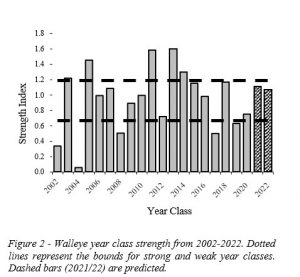 The 2011, 2013 and 2014 year classes were strong, and the 2015, 2016, 2018 and 2020 year classes were of average
The 2011, 2013 and 2014 year classes were strong, and the 2015, 2016, 2018 and 2020 year classes were of average
strength (Figure 2). The 2012, 2017 and 2019 year class are weak. The 2021and 2022 year class are predicted to be average. Recent weak year classes have led to below average abundance. However, it’s not until Walleye are two years old and approximately ten inches when they become fully susceptible to survey gear. At that time biologists determine relative strength of a year class compared to other years.
Small Walleye, from 8 to 10 inches long, are abundant; a possible indication of an upcoming strong year-class (2021). Harvestable-sized Walleye were just below the historic averages (Figure 3).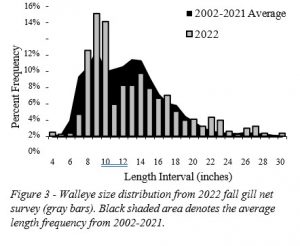
Describing the size of Walleye anglers can expect to catch is fairly simple, but predicting angler success is very difficult due to the variety of biological and environmental conditions that influence angling success. For instance, a major wind storm as the ice forms can make the water very turbid, and thereby reduce angling success.
Anglers are frequently interested in the age of Walleye they have caught. It is rather difficult to provide this information with a great degree of certainty, because individual fish can grow at different rates. Sex of a fish, stage of sexual maturity and various genetic factors all influence growth within a population. Differences in growth between lakes can also be due to climatic conditions and lake productivity.
In general, Walleye in Lake of the Woods reach 12 inches when they are three years old. Male Walleye start to mature when they are 12 inches long and three years old, but it is not until they are 16 inches long and five years old that most male Walleye are sexually mature. Female Walleye grow faster than male Walleye after they reach three years of age. They also mature at an older age. Female Walleye start to mature when they are four years old and 15 inches long, but all of them are not sexually mature until they are nine years old and, at least, 20 inches long. Generally, female Walleye that are 25 inches long are about 10 years old; 30-inch females are about 20 years old.
Sauger outlook. The Sauger population remains at a high level of abundance, at 16 Sauger per gill net lift in 2022 but is below the recent near-shore average of 2002 – 2021 (19/net; Figure 4). Sauger abundance was highest in 2008-10, primarily as a result of the strong year class produced in 2006.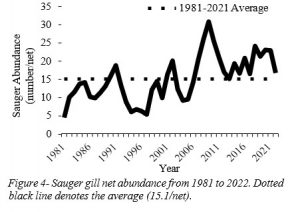
Sauger abundance has been above the 1981-2021 average since 2006. This level of abundance has been maintained by the consistent recruitment of moderate to strong year classes, with relatively few weak year classes (Figure 5). It should be noted that the 2020 year class was weak and the 2021/22 year classes are predicted to be weak. If these predictions hold true, this may result in a lower abundance of future Sauger.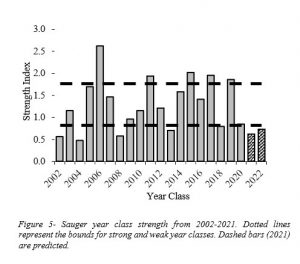
Sauger grow at a much slower rate than Walleye, do not get as large as Walleye, and do not get as old. Typical lengths for Sauger sampled during the fall assessment are 6 inches for age- 1, 8 inches for age-2, 10 inches for age-3 and 12 inches long for age-4 (Figure 6). The largest Sauger we sampled in 2022 was a 17.2 inch long female that was 12 years old.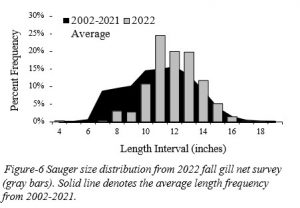
Sauger from 11 through 16 inches were all above the historic average and is the result of excellent recruitment over the past three years. Sauger > 11 inches were below average (a possible indication of weak year-classes produced in 2020/21).
A thorough description of the sampling programs conducted on Lake of the Woods can be viewed on the Baudette Area Fisheries page on the MN-DNR web site (http://www.dnr.state.mn.us/areas/fisheries/baudette/index.htm l)
New Winter Creel Survey Design
Historically, the winter survey was conducted by one creel survey clerk that navigated their way through specific sectors of the lake counting fish houses, checking for occupancy and interviewing anglers while they were actively fishing. Due to the increased fishing pressure and complex ice road network on Lake of the Woods, fisheries managers decided to modify the current winter creel survey design. The new design will incorporate two creel clerks where both clerks will be stationed at pre-determined ice road accesses counting vehicles exiting the lake and conducting interviews for anglers that completed their fishing trip (as done one other large lakes such as Upper Red Lake, Leech Lake and Mille Lacs Lake). As mentioned previously, please do your part for fisheries management and cooperate with the survey.
Trash on Lake of the Woods
An unfortunate side-effect of the high angler use in the winter is the disturbing amount of trash left on the ice, which then washes up on local beaches in the spring. A wide variety of objects, from aluminum cans, to wooden blocks, to plastic bags of human waste, all wash up on private and public shorelines.
To address concerns about the trash levels on the lake, Lake of the Woods County established a partnership with the Lake of the Woods Tourism Bureau, private citizens and business owners, including resorts, and the Minnesota Department of Natural Resources. The charge to this group was to formulate workable solutions, and to educate resource users about the problem.
It is difficult to identify the reasons anglers would leave trash on the ice, but it is likely that some of it blows out of trucks and some may simply be lost in the snow when garbage is stored outside the fish house. To address garbage being lost by accident, consider being more careful when transporting the garbage back to shore. To make garbage easier to find after being stored outside the fish house, try to use garbage bags that are not white. Also, don’t store your garbage outside the fish house when the wind starts to blow. It would be simple to store it in the back of a truck. Finally, remove the wood used to block up your house, and don’t use treated wood for that purpose.
In past years, dumpsters have been provided at popular access locations. Due to hauling costs and other long-term budgetary influences, that program was discontinued. Please continue to do a good job taking your garbage with you, and make arrangements to dispose of trash when you get back to the resort or your home.
Eating fish on the ice?
Many anglers enjoy consuming a portion of their catch on the lake as part of their fishing experience. Since Lake of the Woods has size restrictions (protected slots) on Walleye and Northern Pike, there are some special rules to follow to stay legal. Recall that it is not normally legal to possess Walleye and Northern Pike on the water/ice in a manner in which the length of the fish cannot be determined. Adhering to the following will keep you legal:
While on the ice, all harvested Walleye and Northern Pike must be intact and measureable, unless the person is in the act of preparing the fish for a meal on the ice.
If Walleye or Northern Pike are prepared for a meal, anglers are required to retain the measureable carcasses, which count toward their limit for the remainder of the fishing day.
Do not allow the whole fish or carcasses to freeze together in buckets or bags, since both need to be measureable. Pack them in snow or ice shavings in a bucket or cooler inside the fish house, or vehicle, to prevent them from freezing.
Anglers are required to properly dispose of the carcasses before harvesting additional fish the following day. It is illegal to dispose of fish carcasses on, or under, the ice.
Lake of the Woods Fisheries Management
In December of 2017, DNR Fisheries in Baudette began a management plan review/revision for Lake of the Woods. Stated within the fisheries management plan is a brief background of management history, series of management goals and objectives and management actions. The plan is effective for five years and goals/objectives will be reevaluated in 2023. New to the process this year, we incorporated a Fisheries Input Group (FIG) to provide perspectives and angler expectations. The FIG included 14 individuals from various parts of the state and representing different interests. In the end, a revised management plan was produced that went out for public input. The final document can be found at: https://files.dnr.state.mn.us/fisheries/largelakes/low/low_plan.pdf
Also during the summer of 2018, and parallel to the management planning process, the DNR modified a few Walleye and Sauger regulations (see page 1 of this document).
A brief summary of the modifications are as follows:
Lake of the Woods (May 11th – April 14th) – Effective March 1st 2019 the winter combined possession limit for Walleye and Sauger was reduced from eight to six, with no more than four Walleye. The protected slot of 19
½ inches to 28 inches for Walleye remains in effect, with one fish over 28 inches allowed in possession.
Winter fishing pressure on Lake of the Woods has doubled since the early 2000s from one to two million angling hours annually. In addition, Sauger harvest exceeds management objectives with 80 percent of the harvest taking place during winter. Regulation modifications are a proactive approach to ensure the long-term sustainability of the resource and providing consistency between summer and winter regulations.
Rainy River and Fourmile Bay (May 11th – February 29th) – Same as Lake of the Woods.
(March 1st – April 14th) – Effective March 1st 2019, catch and release fishing is allowed during this time period. All Walleye and Sauger must be returned to the water immediately.
Similar to winter fishing on Lake of the Woods, fishing pressure during the spring on the Rainy River and Fourmile Bay has steadily increased. Annual monitoring of spawning Walleye has also indicated a decline in pre-spawn male Walleye. Regulation modifications are aimed providing protection to pre-spawn males and to reduce overall Walleye harvest from Lake of the Woods/Rainy River; while maintaining spring fishing opportunity.

Click Here to view lodging options around Lake of the Woods.



